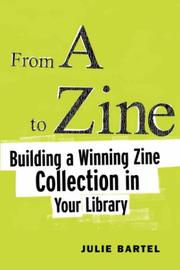| Listing 1 - 3 of 3 |
Sort by
|

ISBN: 0838998100 9780838998106 9780838908860 0838908861 0838908861 Year: 2004 Publisher: Chicago : American Library Association,
Abstract | Keywords | Export | Availability | Bookmark
 Loading...
Loading...Choose an application
- Reference Manager
- EndNote
- RefWorks (Direct export to RefWorks)
Libraries eager to serve the underserved teen-to-twenty-year-old market can make the library a cool place to hang out. All it takes are zines, according to the author, young adult librarian Julie Bartel. Zines and alternative press materials provide a unique bridge to appeal to disenfranchised youth, alienated by current collections. For librarians unfamiliar with the territory, or anxious to broaden their collection, veteran zinester Bartel establishes the context, history, and philosophy of zines, then ushers readers through an easy, do-it-yourself guide to creating a zine collection, includ
Libraries --- Fan magazines --- Underground periodicals --- Alternative periodicals --- Periodicals --- Underground press publications --- Zines --- Fanzines --- Documentation --- Public institutions --- Librarians --- Special collections --- Fanzines. --- Underground periodicals. --- Bibliothèques --- Presse parallèle --- Underground press --- Fonds Spéciaux --- Fonds spéciaux
Book
ISBN: 150176361X Year: 2022 Publisher: Ithaca, New York : Cornell University Press,
Abstract | Keywords | Export | Availability | Bookmark
 Loading...
Loading...Choose an application
- Reference Manager
- EndNote
- RefWorks (Direct export to RefWorks)
"Traces the emergence and development of samizdat as an uncensored system for making and sharing texts. Based on research of the underground journals, bulletins, art folios and other periodical editions produced in the Soviet Union from the mid-1950s to the mid-1980s, this book analyzes the role of samizdat in fostering new forms of imagined community among Soviet citizens"--
Book
ISBN: 1438443730 9781438443737 9781438443713 1438443714 9781438443720 1438443722 1771121017 1771121203 9781771121019 9781771121026 1771121025 9781771121200 Year: 2016 Publisher: Waterloo, Ontario : Wilfrid Laurier University Press,
Abstract | Keywords | Export | Availability | Bookmark
 Loading...
Loading...Choose an application
- Reference Manager
- EndNote
- RefWorks (Direct export to RefWorks)
Making Feminist Media provides new ways of thinking about the vibrant media and craft cultures generated by Riot Grrrl and feminism's third wave. It focuses on a cluster of feminist publications-including BUST, Bitch, HUES, Venus Zine, and Rockrgrl-that began as zines in the 1990s. By tracking their successes and failures, this book provides insight into the politics of feminism's recent past. Making Feminist Media brings together interviews with magazine editors, research from zine archives, and analysis of the advertising, articles, editorials, and letters to the editor found in third-wave feminist magazines. It situates these publications within the long history of feminist publishing in the United States and Canada and argues that third-wave feminist magazines share important continuities and breaks with their historical forerunners. These publishing lineages challenge the still-dominant-and hotly contested- wave metaphor categorization of feminist culture. The stories, struggles, and strategies of these magazines not only represent contemporary feminism, they create and shape feminist cultures. The publications provide a feminist counter-public sphere in which the competing interests of editors, writers, readers, and advertisers can interact. Making Feminist Media argues that reading feminist magazines is far more than the consumption of information or entertainment: it is a profoundly intimate and political activity that shapes how readers understand themselves and each other as feminist thinkers.
Social justice. --- Gender identity. --- Race relations. --- Communication --- Third-wave feminism. --- Zines. --- Communication and culture --- Integration, Racial --- Race problems --- Race question --- Relations, Race --- Ethnology --- Social problems --- Sociology --- Ethnic relations --- Minorities --- Racism --- Sex identity (Gender identity) --- Sexual identity (Gender identity) --- Identity (Psychology) --- Sex (Psychology) --- Queer theory --- Equality --- Justice --- Periodicals --- Underground periodicals --- Feminism --- Social aspects. --- Zines --- Emancipation of women --- Feminist movement --- Women --- Women's lib --- Women's liberation --- Women's liberation movement --- Women's movement --- Social movements --- Anti-feminism --- History --- Emancipation --- Gender dysphoria
| Listing 1 - 3 of 3 |
Sort by
|

 Search
Search Feedback
Feedback About UniCat
About UniCat  Help
Help News
News